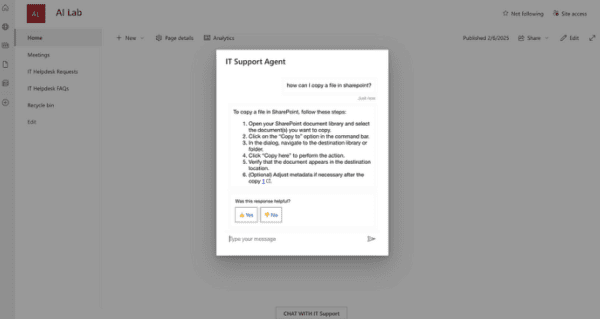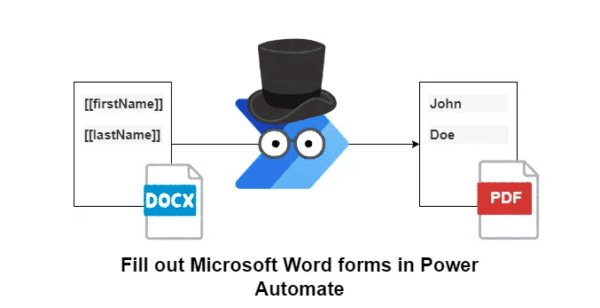Sharing files is important for both companies and single users. High-speed networks allow you to share files without needing to write them to a flash drive and copy them manually for each user. Microsoft provides many capabilities for sharing files, from a traditional file server that uses SMB protocol to more advanced cloud-based services such as OneDrive and SharePoint. This blog post covers Microsoft Office SharePoint, explains what SharePoint is used for, and how you can use SharePoint with a focus on SharePoint Online.
What Is Microsoft SharePoint?
Microsoft SharePoint is a collaboration platform developed for sharing files and simultaneous editing of shared files. When using standard sharing features and sharing files using the SMB (CIFS) protocol, only one user can edit a file at a time. Once a file shared by using SMB is opened by a user, other users can open this file only as a copy. Changes saved by the first user are not visible to other users until they re-open the file kept by the first user. Other users can save a copy of the file with their changes. Each file copy contains different shifts, and it is difficult to merge all changes into a single file. This approach may not be convenient for collaboration-intensive processes when multiple users have to edit the same file simultaneously. Microsoft SharePoint is developed to resolve this issue, allowing multiple users to edit a shared file and save changes to the file.
What Is Microsoft SharePoint Used for?
Microsoft SharePoint is a platform for sharing files at your organization, creating sites and libraries to organize content, managing files, automating business processes, and facilitating team collaboration. SharePoint is used to improve teamwork efficiency. SharePoint is usually used by medium-sized and large organizations with more than one hundred users when the traditional file servers’ functionality is insufficient.
What Is Microsoft SharePoint Online?
SharePoint Online, launched in 2001, is a cloud-based version of Microsoft SharePoint and is part of the Microsoft Office 365 suite. If you use SharePoint, you need to deploy a SharePoint Server manually, and then you have to support a standalone SharePoint Server, related storage, Active Directory, install security patches, etc. The locally-hosted SharePoint Server is autonomous and is fully under your control.
If you use SharePoint Online, also called SharePoint 365, all software updates are installed automatically on Microsoft datacenters once they are released. All tasks related to maintenance and support are performed by Microsoft. An organization must pay for using Microsoft Office 365, including SharePoint Online, on a per-month subscription basis. There are no difficulties in configuring access to a SharePoint portal from any place in the world where users have an internet connection (unlike traditional Microsoft SharePoint Server that is running on an intranet).
How Does Microsoft Office SharePoint Work?
As mentioned above, Microsoft Office SharePoint is a collaboration and document management software that can be installed on a Windows Server on premises or run in Microsoft datacenters in the cloud as part of Microsoft Office 365. Here’s an overview of the main components of SharePoint.
A SharePoint site is a collaborative hub, a web portal to store files and share documents with members of your team. There are two types of SharePoint sites – a team site and a communication site. A team site connects your team to content, includes a group of web pages, document libraries to store files, customizable web elements, and lists to manage data. A communication site is a place to share information with others, and it is used to broadcast information to a specified audience.
A SharePoint library is a location on a SharePoint site used to create, update, upload, and collaborate on files with other users on your team. Information about the last change made in a file and about the user who made the change are displayed in a SharePoint library.
A SharePoint list is a collection of data intended to organize information on a site by users in a flexible way. Users can add custom columns to display different types of data for files such as date, time, currency, text, etc. Lists are used to sort, organize, and filter data in different ways and help users track versions and change history of shared files.
SharePoint can be considered as a set of sites that are automatically generated by using the ASP.NET technology with IIS and content stored in an MS SQL database that interacts with other applications and platforms (for example, MS Exchange, MS Project, etc.). As you can see, traditional server roles are used:
- Web servers
- Application servers
- Database servers
From another point of view, SharePoint is a content management system (CMS) inside which content is divided into different logical blocks. The largest logical block is a SharePoint Site Collection that is related to the URL of a site home page and a web application on an IIS server. A site collection contains multiple sites. It is important to understand the structure of SharePoint sites for correct URL naming related to DNS names of a SharePoint portal. Just like traditional file systems, the logical site structure affects the permissions that are inherited from parent objects. Permissions set to a group on a root site level are applied to access any object of this site.
How do I access Microsoft SharePoint? You can access a SharePoint portal by opening a link in a web browser. For example, if you use SharePoint online, a link to access a SharePoint portal looks like:
https://your-company.sharepoint.com/SitePages/Home.aspx
Features of SharePoint Online
There are useful features provided by SharePoint Online to make life easier. Let’s look at some of them.
File versioning is a great feature that allows you to restore previous versions of documents stored in lists or libraries after they are changed. File versioning is useful to track change history, view previous versions, and revert to a previous version when you have unwanted changes saved to a file.
Indexing is a point for fast and precise file search. This feature allows you to easily access files. Find the needed information quickly by using Microsoft Search. Indexing is the mechanism that scans all files on your site to sort and integrate scanning results to a search database. When you enter a search query, it is faster to search in the indexed search database than in the entire file storage.
Windows integration. SharePoint Online can be integrated with on-premise servers running Windows Server. You can configure Windows 10 drive mapping to SharePoint.
Web browsers support. SharePoint sites can be accessed in popular web browsers and from standalone Microsoft Office applications. Accessing SharePoint sites from mobile versions of web browsers is supported.
Permissions management is used to configure access to shared documents in SharePoint Online. Grant permissions for certain users and restrict permissions for others. Set permissions for groups of users. For example, users of one group can write changes to shared files, and users of another group can open files only in read-only mode.
Governance. Configure data governance policies if your company operates with confidential and sensitive information that you want to protect. You can also read about data governance tools for Office 365.
Secure storage for documents. Files stored in the Microsoft cloud are encrypted. Encryption is enabled for network connections when accessing documents in SharePoint Online. You can configure two-factor authentication for your Office 365 account.
Management with PowerShell allows you to use automation for SharePoint Online configuration by creating scripts and running them in the command line interface. Using PowerShell is convenient when performing repetitive tasks.
SharePoint Deployment Options
There are three deployment options for SharePoint.
SharePoint on premises. A standalone version of Microsoft SharePoint Server such as SharePoint 2019, SharePoint 2016, etc. can be installed on physical servers or virtual machines in your office or data center, giving you full control of SharePoint in your organization.
SharePoint Online is a cloud-based implementation of SharePoint. There is nothing to install, you should only buy an Office 365 subscription with the appropriate subscription plan that allows you to use SharePoint Online.
SharePoint Hybrid is a mixed deployment option when using both SharePoint Online and SharePoint Server running on-premises. Local and cloud SharePoint environments are synchronized for data sharing and integration.
SharePoint Licensing
How much does Microsoft SharePoint cost? The price is different for online and on-premises versions of SharePoint.
SharePoint Online uses a per-user subscription model.
- SharePoint Online Plan 1: $5 per user/month
- SharePoint Online Plan 2: $10 per user/month
- Office 365 E3: $20 per user/month
A client access license (CAL) model is used for the on-premises version of SharePoint. Each SharePoint user needs one CAL.
- SharePoint Standard CAL: $180 per license
- SharePoint Enterprise CAL: $180 per license (one-time purchase)
- SharePoint Server license: $5,000 per server (per VM)
- SharePoint Foundation license: Free
You may also need to buy MS SQL Server licenses.
Conclusion
This blog post has covered Microsoft Office SharePoint, the working principle behind SharePoint, main features of SharePoint Online, price, and deployment options. SharePoint is used to share documents and edit documents by multiple users simultaneously. A web interface used to access SharePoint allows users to use SharePoint on different operating systems and edit documents in a web browser even if Microsoft Office is not installed on their devices. SharePoint Online is part of the Office 365 SaaS platform. It can be used after buying the appropriate subscription plan without the need to install and configure Microsoft SharePoint Server in a local environment. Even if you use SharePoint Online, don’t forget to perform backups of your SharePoint data. One of the most popular backup software for SharePoint is NAKIVO Backup & Replication, which supports backup of SharePoint Server and SharePoint Online, in addition to other Microsoft Office 365 data.
You can find more SharePoint blogs on our dedicated SharePoint page.
About the Author:
Olivia Cox is a product manager specializing in Microsoft 365 and Amazon services. She started her career path in 2008 as a system engineer at a local insurance company in Dallas. Today, she leads the development of data protection products that support SaaS and cloud environments. Olivia is a true tech enthusiast who never stops searching for inspiration. She blogs about data protection, Microsoft 365, and cloud computing trends.










 Using a SharePoint Online list as a Knowledge source via ACTIONS in Copilot AI Studio
Using a SharePoint Online list as a Knowledge source via ACTIONS in Copilot AI Studio
